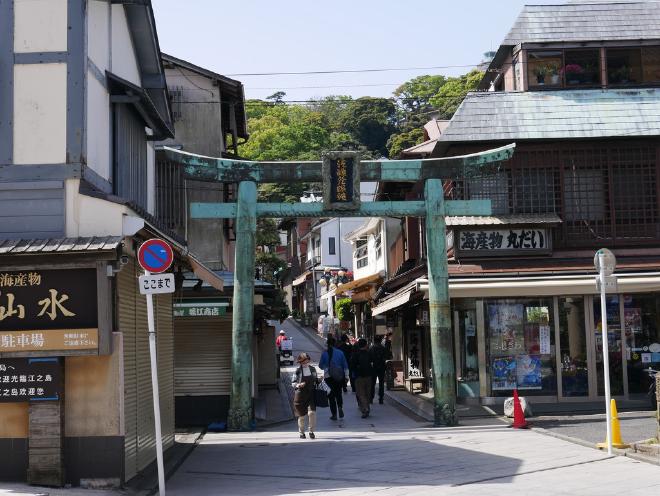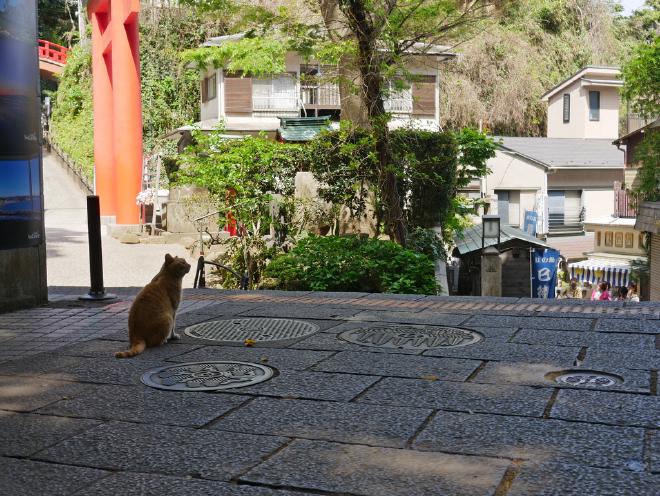Day 2: Enoshima, Yokohama Ramen Museum
Table of Contents
Enoshima #
The next morning Van and I hopped on a JR train to Fujisawa Station, where we transferred to the Enoshima Electric Railway. From there, we paid our fares with our SUICA cards to get to Enoshima Station.
From the station, it was a quick walk to the bridge that took you to Enoshima, a tiny island off the coast to the south of Tokyo. I’d known, coming to Tokyo, that I would find Tokyo itself quite suffocating — there’s just so many people 😩 — and that the majority of the sightseeing I’d want to do would be further out, one to two hours away, as Enoshima was.

It was a clear day but so windy as we crossed the bridge. Luckily once we got onto the island, we were more protected from the elements. We were met immediately by charming shops, restaurants and cafes that lined Benzaiten Nakamise Dori, the main avenue, but it was mid-morning and most of them weren’t open yet.

Van and I did slip into one of the lone stores that was open, a gift shop where she bought a cute coin purse to hold her Japanese cash.
The avenue sloped upward, leading to Enoshima Jinja Shrine, which actually is a series of shrines scattered around the island dedicated to Benten, a goddess of good fortune, wealth, music and knowledge.
We started to ascend the steps that took you further up the island — there would be lots and lots of stairs to traverse — but were met by a shrine cat, which immediately made my day better. It even let me pet it. Enoshima tourism literature calls itself “Cat Island” but honestly this is the only cat we saw the entire day. Nevertheless, still a win!


We passed a small public garden, where an older man sat on a rock beside a water feature with an owl perched on his arm. 🦉 I approached him and asked in my broken Japanese if it was okay to take a picture. The man said yes while specifying that he didn’t want to be in the picture. Van and I admired the owl — Kome-chan, we learned — while chatting with the man, who was very friendly and curious, asking where I was from and how I came to know Japanese.

Happening upon a random owl was one of Vannie’s favorite moments of the day.
At the top of the island, we entered the Samuel Cocking Garden, which started out as the private garden of British merchant Samuel Cocking in 1882. Entry normally costs ¥700 for adults but for whatever reason they were letting visitors in for free that day, perhaps because there was work being done inside the garden.
The Enoshima Sea Candle, an observation tower, is also located in the garden but we opted not to pay the fee to climb it; the views from the top of the island were enough for us.
Van and I made our way to the Iwaya Caves, an ancient religious training location. The caves were created by erosion by the waves. They were opened to the public in 1993. The highlight of the self-guided tour of the two caves was when they gave us candle lanterns to take with us. The caves have enough electric lighting so that the lanterns weren’t necessary but they added to the atmosphere.
Not far from the caves was a spot popular with kites, a kind of hawk. The wind was so strong they almost looked like they were essentially hovering in mid-air. We’d seen signs along the walkway warning visitors to keep a close eye on their food, as apparently the kites are known for dive bombing easy targets.
By the time Van and I made our way back to Benzaiten Nakamise Dori, the crowds were in full force and all the shops open, so I’m glad we’d come early in the day.

We ate at Pico, an Italian restaurant on the street leading back to Enoshima Station. I got a nice creamy gnocchi and Van, a carbonara pasta.
Shin-Yokohama Ramen Museum #
We took the Enoshima Electric Railway back to Fujisawa Station, where we took a brief detour to breeze through fabric and stationery shops as well as the local public library in the adjoining building.
At Fujisawa South Public Library, I was amazed to see nearly every seat was taken up by someone in the actual act of reading books. I say this because American libraries have evolved into such multipurpose buildings that when you visit them, there are just as many people using the computers or working on their laptops or participating in a program as there are people there for the actual reading material. So I thought it was so interesting how reading-heavy (and dead silent) the library seemed to be.
We continued on by train to Shin-Yokohama Station, where we disembarked and walked the short distance to the Shin-Yokohama Ramen Museum.
Adult admission was ¥380 (about $3), which honestly felt so cheap compared to American museum prices. This isn’t a knock at American museum prices — I understand they need to price accordingly to be able to keep their doors open and provide quality exhibits — but given that the quality of the ramen museum’s exhibits felt just as good for a museum of its smaller size, I honestly don’t understand how the ramen museum can price their admission so low.
We spent some time perusing the exhibits depicting the history of ramen in Japan but it’s the basement floor that we found most delightful. The entire floor is a replica of 1950s Tokyo, with nine ramen restaurants, each featuring ramen from different regions of Japan. You order via ticket vending machines at the front of each store.

It was still mid-afternoon so we didn’t have any appetite to eat anything yet but we enjoyed meandering around the dark corridors and store fronts. They were so detailed and evocative and really transported you to another place and time in the same way that Diagon Alley and Knockturn Alley do at Universal Studios Orlando.
We still had some time left before turning in for the evening, so we took the train to Shibuya Station to check out Map Camera, a big camera shop known for good prices on new and used products. They didn’t have the lens I was looking for secondhand, either, but Van spotted another shop not far away, Kitamura Camera, which did.
I’ve long had a digital camera but it was the first time I’ve bought an additional lens for it. I was excited to be able to take advantage of Tokyo’s secondhand camera gear marketplace.